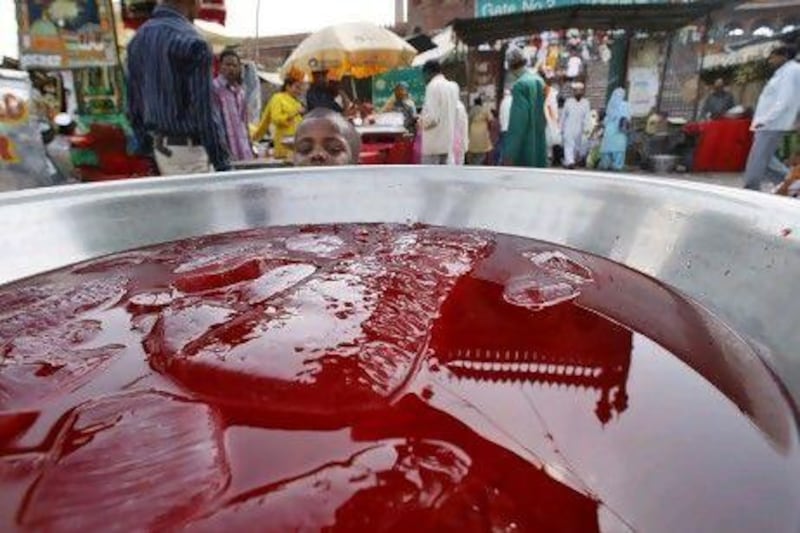NEW DELHI // In September 1995, when Sumukh Herlekar was 10 years old, a rumour swept India that idols of the Hindu god Ganesha were magically "drinking" milk that was fed to them. Mr Herlekar joined a long queue at his neighbourhood temple, but into his glass of milk, he had mixed a syrup named Rooh Afza.
For this, recalled Mr Herlekar, who now works for a software company in Mumbai, he was "severely reprimanded". But to his young mind, the logic was clear: on a hot day, nothing improved a draught of milk like Rooh Afza.
For more than a century, the onset of the fierce summer in India and Pakistan has been indelibly linked with Rooh Afza's rose-pink tint and its flavour of flowers and fruits. Remarkably, Rooh Afza's appeal has endured, even in a market that has, for a couple of decades now, been awash with American colas.
"The quarter from March to July, which coincides with the start of the Indian summer, accounts for 70 per cent of our sales," said Tarundeep Singh Rana, the general manager for marketing at Hamdard, the company that manufactures Rooh Afza.
The market for concentrate syrups in India, Mr Rana said, was worth about 4 billion rupees (Dh279 million); Rooh Afza controls just over half of that market.
Rooh Afza is technically a sharbat, a slightly too-sweet concentrate of the kind also common in the Middle East, and introduced into India by its Mughal rulers. The ingredients of Rooh Afza include the essences of coriander, orange, pineapple, carrot, rose petals, spinach and mint.
Sold in a bottle with a distinctive yellow cap, Rooh Afza is often mixed with cold water or milk, poured over ice cream, or licked surreptitiously off a spoon. Anand Ramachandran, a game designer at Zynga in Bangalore and a recent Rooh Afza convert, mixes it to create a summer cocktail.
In the older parts of Delhi, and in other towns across northern India, sharbat sellers still stand with containers of ice and water, armed with bottles of Rooh Afza.
Its appearance and its flavour even moved the 20th-century Urdu poet Sa'il Dehlvi to verse. Its colour "enchants your heart" and its fragrance "outstrips that of the flowers," he wrote. "Never has there been a sharbat like Rooh Afza, and never will there be."
As a company, Hamdard dates back to 1906, when a doctor of herbal medicine, Hakim Abdul Majeed, founded his clinic in New Delhi. Rooh Afza, among Hamdard's first products, was introduced in 1907; Hamdard's portfolio of products now numbers nearly 600.
The name "Rooh Afza" has popularly been translated as "refresher of the soul," but Hamdard's own website - currently under renovation - admitted that the brand's precise origin is unclear. "Some think that this name is a product of [Hakim Majeed's] mind," an explanation read.
The company considers, as alternative possibilities, the character Rooh Afza in the book Masnavi Gulzar-e-Naseem by the 19th-century Kashmiri poet Daya Shankar Naseem, as well as a weekly magazine named Rooh Afza, which was published in the late 19th century in Jaunpur, in Uttar Pradesh state.
The history of Hamdard has, in a way, followed the history of the subcontinent. When India and Pakistan separated in 1947, the company split as well, and an independent Hamdard was founded in Karachi, Pakistan. Hamdard Pakistan today exports Rooh Afza to, among other countries, the UAE.
Similarly, when East Pakistan broke away in 1971, the branch of Hamdard that had been set up in Dhaka in 1953 turned into Hamdard Laboratories, Bangladesh.
Part of Rooh Afza's continuing appeal lies in its memories. Indrojit Chaudhuri, a 36-year-old entrepreneur based in New Delhi, recalled the thrill of "sneaking up to the fridge, when the [rest of the house] was enjoying a siesta, and taking a lick right out of the bottle."
As a child, Mr Chaudhuri commonly threw tantrums and rolled on the floor if any other drink was purchased at the store. When guests came to visit, he said, he and his brother would be particularly eager to serve them Rooh Afza, so that they could mix themselves a glass as well.
Another part of Rooh Afza's appeal, though, lies in its mystique, said Santosh Desai, a New Delhi-based analyst of brands and marketing strategies.
"Rooh Afza still has a certain air of being an exotic concoction, a mystery in terms of what goes into it, and it has that extravagant, right colour," Mr Desai said. "It has a sense of heritage as well, and a sense that it has medicinal, cooling properties in a hot country."
Hamdard claims that Rooh Afza has - according to the traditional Indian medicinal system of Ayurveda - therapeutic and nutritional qualities that work on the body particularly well in summer. It supplies essential electrolytes and corrects "the function of the heart, liver and kidney," according to company literature.
The qualities have, in fact, also made Rooh Afza a popular way to break the Ramadan fast for Muslims during the holy month.
But Hamdard may not be capitalising on Rooh Afza's innate appeal, Mr Desai said.
Its more recent marketing strategies - including a 2010 campaign starring the Bollywood actress Juhi Chawla - imply that "it believes in its own growing irrelevance, when it absolutely doesn't need to."
"Somehow there's a belief that to stay relevant, you have to modernise, say things like 'Yo!' in your advertising - a belief that to sell anything means to sell it like a cola," Mr Desai said. "But in terms of what it delivers, Rooh Afza has a story and a heritage and depth. It doesn't need to be sold like a cola."
[ ssubramanian@thenational.ae ]
Follow
The National
on
[ @TheNationalUAE ]
& Samanth Subramanian on
[ @Samanth_S ]





